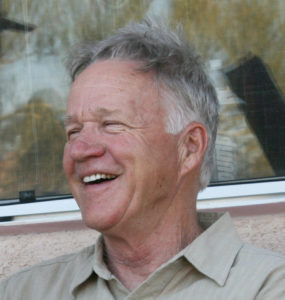About the Talk
Geology of the San Juan Islands
 The San Juan Islands record geologic growth of the western edge of North America by very active plate tectonics, which added exotic terranes ~400 to 100 million years ago. These terranes came from distant origins—Asia, Greenland, and the ancestral Pacific Ocean. The terranes moved through the ocean realm; they accreted by subduction at the continental edge, perhaps in N. California, at depths of 20-30 kilometers or more. These old rocks were then exhumed and transported north in a “forearc sliver” along the continental margin. They eventually collided with and stacked up on the south-facing edge of Wrangellia (Vancouver Island) and on the south end of the active Coast Plutonic Complex (a magmatic arc). At this point in San Juan Islands evolution, ~ 100 million years ago, the major tectonic elements were pretty much as they are now: The Islands were composed of stacked thrust sheets on the southeast edge of Wrangellia, and major plutonism emplacing younger rocks in the southern B.C. Coast Mountains.
The San Juan Islands record geologic growth of the western edge of North America by very active plate tectonics, which added exotic terranes ~400 to 100 million years ago. These terranes came from distant origins—Asia, Greenland, and the ancestral Pacific Ocean. The terranes moved through the ocean realm; they accreted by subduction at the continental edge, perhaps in N. California, at depths of 20-30 kilometers or more. These old rocks were then exhumed and transported north in a “forearc sliver” along the continental margin. They eventually collided with and stacked up on the south-facing edge of Wrangellia (Vancouver Island) and on the south end of the active Coast Plutonic Complex (a magmatic arc). At this point in San Juan Islands evolution, ~ 100 million years ago, the major tectonic elements were pretty much as they are now: The Islands were composed of stacked thrust sheets on the southeast edge of Wrangellia, and major plutonism emplacing younger rocks in the southern B.C. Coast Mountains.
An additional element to this tectonic wreck was the 100-65 million-year-old marine Nanaimo basin, surrounded by Wrangellia to the west, the San Juan Islands lying south, and the Coast Plutonic Complex on the east. A several kilometer-thick section of marine sands, conglomerates, and shales accumulated. These beds are rich in fossils, including a Tyrannosaurus dinosaur bone from Sucia Island. Distinctive cobbles give evidence of when the San Juan Islands terranes arrived. Sucia Island’s distinct horseshoe shape is a result of later folding into a syncline.
Unconformable on the Nanaimo Formation are the subaerial river-deposited sandstones, shales, and conglomerates of the Chuckanut Formation, ~60-50 million years old. These sediments accumulated to a thickness of some six kilometers (!) in a subsiding basin marginal to the coast. Fossil palm trees and crocodile footprints point to a tropical setting. Interestingly, the Chuckanut Sandstone is the major building stone for Port Townsend’s old masonry buildings.
Finally, during a period ~ 20,000 to 15,000 years, ago the San Juan Islands were overrun by a mile-thick glacier flowing south as an extension of the continental “Cordilleran Ice Sheet” lying mostly in Canada.
 About the Speaker
About the Speaker
Born and raised in Excelsior, Minnesota, Ned Brown attended Dartmouth College (A.B., 1960), the University of Otago, New Zealand (M.Sc., 1961-62 supported by a Fulbright scholarship), and the University of California, Berkeley (Ph.D., 1963-66) with his field area in New Zealand.
He was employed as a Geology Professor at Western Washington University from1966-1999, then was appointed as an Emeritus Professor. Over these years he supervised ~30 M.S. student theses, nearly all in the local region.
His geology research interests include metamorphism, structure, plutonism, plate tectonics while working extensively in the San Juan Islands, North Cascades, and Coast Mountains of southern B.C.
